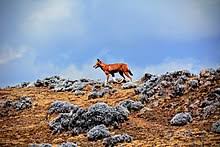
Short explanation
Bale Mountains National Park was primarily established for the protection of the Endemics Mountain Nyala and Ethiopian Wolf, and other features including the spectacular scenery, an extensive Afro-alpine plateau and the moist highland forest. The park is located South-East of Addis Ababa within an altitude range of 1500-4377 m above sea level. The entry gate is located 400km from Addis near Dinsho town in Bale zone. The park receives up to 1,200 mm of rainfall annually. It experiences 8 months of rain with heavy rains in April, August to October and light showers usually in the afternoons in the months of May to July. This is then followed by 4 months of dry season.

The park harbors diverse Flora and Fauna, with the fauna largely including the Mountain Nyala, Menelik’s Bushbuck, Ethiopian Wolf, Bohor Reedbuck, and Common (grey) Duiker, Common Jackal, Serval Cat, Leopard, Klipspringer, Warthog, Rodents and birds. There are endemic mammals like the Mountain nyala, Starck’s hare, Bale monkey, Giant molerat, Lovat’s mouse, Nikolaus mouse, Mahomet’s mouse, White-footed rat, White-tailed rat, Grey-tailed rat, Blick’s grass rat and Scott’s-hairy bat.

The endemic birds in the park include the Abyssinian catbird, Abyssinian longclaw, Yellow-fronted parrot, Spot-breasted plover, Black-headed siskin and Golden-backed woodpecker. Other birds once used to be endemic include Watteld ibis, Blue-winged goose, Rouget’s rail, white-collared pigeon, Black-winged lovebirds, Banded barbet, White-winged cliff-chat, White-backed black tit, Black-headed forest oriole and Thick-billed raven.

The major characteristics of the Bale Mountains National Park include the extensive plateau, valley and the lava outpourings. Over forty streams arise within the park. These join to form four major rivers- the Webe Shebelle, the Web (leading to the Genale and Juba rivers), the Wemel and Dumal Rivers. The most notable floras of the park are Giant lobelias, Kniphofia, Helichrysum splendidum, Hypericum revolutum, Hagenia abyssinica/ kosso/ and Juniperus procera. The best time to visit the park is from November to March.

Long description
Northern grasslands (Gaysay Grasslands)
Mountain nyala & Bohor reedbuck in the Gaysay Grasslands
The Northern grasslands, spanning the Web and Danka Rivers, are situated to the south of the Bodeti Mountain and north of Adelay ridge, and northwest of Dinsho. The altitude of the area ranges from 3,000m to 3,500m, pushing the upper limit for tree growth. The land is flat, dominated by swamp grasses and sedges, especially of the Cyperus and Scirpus genera and becomes muddy during the rainy season. Higher areas are scrubby with African or wild wormwood (Artemesia afra) and Cape gold (Helichrysum splendidum), one of more than ten species of everlasting flower found in Bale. Both are important sources of food for the mountain nyala and sources of shelter for other animals. Hagenia abyssinica trees flower from November through February; female trees boast an impressive red bloom. Wild fennel also grows here.

The Northern grasslands are the best place for viewing the endemic mountain nyala* – sometimes up to 50 in a herd. Also ever present, bohor reedbuck, play an important role in the ecosystem as they are the only grazers in this area of the park. Other mammals that are commonly seen are warthog, grey duiker, serval, and golden (common) jackal, along with the spotted hyena at night.

Birds that can be seen include the Abyssinian longclaw*, winding cisticola, marsh harrier, Abyssinian ground hornbill, spot-breasted plover*, Rouget’s rail**, wattled ibis**, Abyssinian catbird* and many more.

Juniper Woodlands (Park Headquarters)
The juniper woodlands cover the northern slopes of the Bale massif, reaching from Dodola to Dinsho. These woodlands are under intense pressure from grazing, inhibiting the growth of new trees. Hagenia abyssinica and African juniper (Juniperus procera) dominate the woodlands. At the upper limit of their distribution, the juniper trees are smaller than in other parts of the park. In contrast, the Hagenia trees can grow to be massive, flowering from November to February. St John’s wort (Hypericum revolutum) is also common in the woodlands, growing as shrubs near the lower edge and reaching a height of 5m in the upper tree line. They are easily recognizable by their bright yellow flowers, which bloom throughout the year and are the major source of nectar for the honey produced in the area. Also present is the only indigenous rose to Africa (Rosa abyssinica), which has fragrant, white flowers.

Mountain nyala*, warthog, Menelik’s bushbuck*, colobus monkey and olive baboon can be spotted in the area.
Birds to look for include the wattled ibis**, Abyssinian catbird*, white-backed black tit*, Abyssinian ground thrush, gold-mantled woodpecker**, red- breasted wryneck, thick-billed raven** and many more.

Afroalpine Meadows (Sanetti Plateau & Upper Web Valley)
Sanetti Plateau. Photo by Vincent Munier.
Due to the altitude, plant diversity here is low. However, one of the notable plant species is the giant lobelia found from 3,100m to 4,377m growing to a maximum height of 6m. On the plateau stands Tulu Dimtu at 4,377m. This is the second tallest mountain in Ethiopia, and the tallest in Bale.

Found at staggeringly high densities in Afroalpine meadows (average of 2,500kg per km2) Afroalpine rodents (mice, rats, and molerats) dominate the cold and seemingly barren plateau. Look specifically for the giant molerat* (endemic to the Bale Mountains), rock hyrax and Starck’s hare*. The plateau is also home to Ethiopian wolves* and a trip to the plateau all but guarantees a sighting of this charismatic carnivore. The plateau hosts a large number of raptors that feed on the sizeable rodent population. Look for augur buzzards; Verreaux’s, tawny and steppe eagles; lanner falcons; kestrels; and the lammergeyer or bearded vulture. This is also the most southern resident and breeding area in the world for golden eagles. The lakes, rivers and swamps attract many Palearctic waders. Look for the endemic blue-winged goose* (the rarest and most isolated goose in the world); spot-breasted plover*; and ruddy shellduck (like the golden eagle, the ruddy shellduck population is unique and isolated). Additionally, the population of red- billed chough is the most southern population in Africa. Several pairs of wattled crane are also present on the plateau – the northernmost population in Africa.

Erica Belt: Moorlands and Forest
Located immediately above the tree line, from 3,400m to 3,800m, is a belt of heather made up of species of the Erica and Phillippa genera, dominated specifically by Erica arborea (tree heath), a shrub common throughout the world that grows to staggering proportions in Bale – up to 5m on the edge of the tree line. These forests are a fairytale wood of giant heather dressed in moss and old man’s beard (a lichen). These trees are highly endangered and quite rare in Ethiopia. The most accessible example of this type of forest is on the road that crosses the Sanetti plateau, 100m above Rira.

Mountain nyala*, Menelik’s bushbuck*, and grey duiker live in the area in relatively large numbers, but are hard to spot due to vegetation densities. Klipspringers and hyraxes are also common. The Bale Mountains are the only area where both male and female klipspringers have horns.
Look for moorland and chestnut-naped francolins, Alpine chat and Rouget’s rail**.

Harenna Forest
The southern and largest area of the park consists of the second largest forest in Ethiopia: the Harenna forest. Along with the adjacent State- and community-managed forest outside the park, it constitutes an area of over 4,000km2. It is also the largest cloud forest in the country. The road from the plateau takes you down the Harenna escarpment and into the forest. Mountain bamboo grows within the forest, particularly on steep slopes. Rubus steuderi, a member of the blackberry family, grows along the road from April to June. The upper area of the Harenna forest is wet cloud forest with an extensive bamboo belt, while the lower parts are drier mountain forest. At about 2,200m as the slopes become gentler, larger trees of up to 30m tall appear, and the canopy closes. These include fern pine (Podocarpus gracilior) and fig trees (Ficus spp.) of massive girth. Branches are covered with dense epiphytes. In the lower areas of the forest, wild forest coffee (Arabica sp.) grows.

Because the forest is so dense and clearings are few and far between, the elusive animals of the forest have little trouble staying hidden. Black-and-white colobus monkey, olive baboon, warthog and Menelik’s bushbuck* are common. With a little luck and perseverance, you might see a giant forest hog, a bush pig or an endemic Bale monkey*. Clearings are the best places to look for lion, leopard and African wild dog. Genet, civet, porcupine, and hyena are all active at night.

Birds of the Harenna forest are equally elusive. Look for the Abyssinian hill babbler, Abyssinian crimson-wing, Ayre’s hawk eagle, silvery-cheeked hornbill, black-winged lovebird**, Abyssinian oriole**, yellow-fronted parrot*, white-cheeked turaco and narina trogon. A wide range of migrant birds can also be spotted, including Palearctic warblers.

